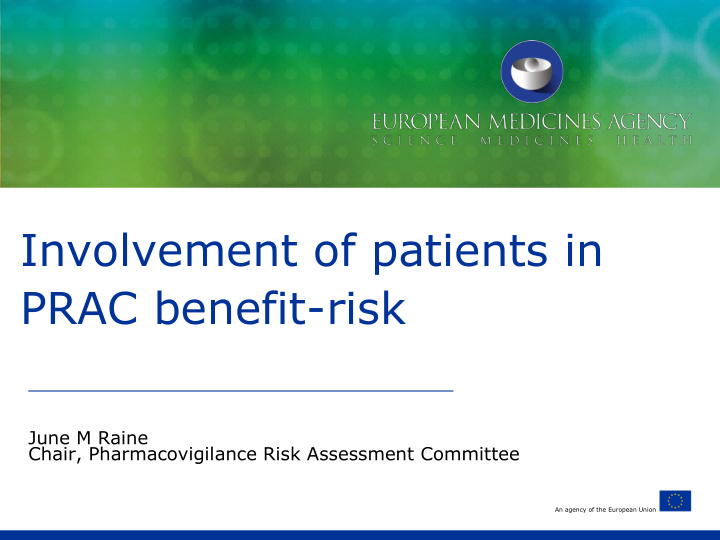



Involvement of patients in PRAC benefit-risk June M Raine Chair, Pharmacovigilance Risk Assessment Committee An agency of the European Union
Outline of presentation What was experience of patient observers in Pharmacovigilance Working Party? Why is patient perspective vitally important to work of the Pharmacovigilance Risk Assessment Committee? How can patient involvement in PRAC benefit risk be optimised? 1
Pharmacovigilance Working Party Pilot conclusions -2009 1. The patient and medicines user: final arbiter of acceptable risk 2. Patient view important to put safety information into context (clinical practice, public health) 3. Identify topics requiring additional PCO consultation; act as link to other experts 4. Facilitate implementation of new legislation
Patient Observers Albert van der Zeijden Chairman of IAPO Greetje Goossens EMP counsellor Cristina Cabrita BEUC
Key learning from PhVWP experience • Perspective of patient observers not necessarily same as scientific/technical experts • Provides an extra dimension which adds value and builds a more rounded evaluation • Value of patient contribution throughout entire range of issues, not only drafting of patient information
Aims of Pharmacovigilance legislation • Clarity on roles and responsibilities • Proactive safety monitoring • Robust and timely decision-making leading to consistent action on safety issues for nationally and centralised authorised products • Best use of resources – avoiding duplication of effort • High levels of transparency • Greater inclusiveness for patients and healthcare professionals
Mandate of the Pharmacovigilance Risk Assessment Committee All aspects of the risk management of the use of medicinal products including the detection, assessment, minimisation and communication relating to the risk of adverse reactions, having due regard to the therapeutic effect of the medicinal product, the design and evaluation of post-authorisation safety studies and pharmacovigilance audit
Membership of PRAC Appointed by Appointed by each Member European State: Commission: 6 members - relevant expertise 1 member + alternate including clinical pharmacology 27 + EEA countries non and pharmacoepidemiology voting members 1 member/alternate representing patient organisations 1 member/alternate representing healthcare professionals
Why patient involvement at PRAC? Patients will have key role in evaluation of: • What benefit is meaningful • What risk is acceptable • Whether balance of benefits and risk is favourable and in what population • How evidence of benefit risk is communicated to support decision-making
Evidence from Patient Reporting • Similar proportion of “serious” adverse drug reactions • More detailed description of adverse drug reaction • More signals when combined HCP and patient reports • Different patterns of drugs and reactions reported by patients Avery et al 2011
Example: Tolcapone (Tasmar)
Patient representatives -added value • Input into implementation of new pharmacovigilance systems • Promotion of adverse reaction reporting • Safety issues where public hearings will be appropriate • When to involve specific patient organisations
Example – choice of Black Symbol For medicines subject to Additional Monitoring All new active substances and biologicals, including biosimilars; obligation to conduct a safety study, or to conditions or restrictions (optional) Views of patients/consumers were key to selection of symbol by PRAC
PRAC Referrals Sept-Nov 2012 Codeine (analgesia) - toxicity in children Diclofenac - cardiovascular risk Short-Acting Beta-Agonists - in obstetric use Hydroxyethyl starch solutions - morbidity/mortality Almitrine - neuropathy Diacerein - hepatotoxicity What issues would be appropriate for a public hearing?
How can patient involvement in PRAC be optimised? Clarity on scope of role Tailored induction Support and briefing Monitoring and feedback
Conclusions Patient representatives are integral to the new Pharmacovigilance Risk Assessment Committee, and key to achieving greater inclusiveness of European drug safety systems Patients’ contribution to a robust benefit -risk evaluation is vital Now that PRAC is established, preparing for the optimal involvement of patient representatives is a priority
Recommend
More recommend